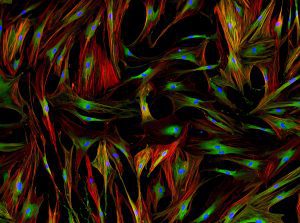What are Digital Images?
Most images nowadays are recorded in digital form. From a mathematical point of view, they are just 2-dimensional or multidimensional arrays containing values of pixel signals. In simplest binary images each pixel can have only 2 values: zero and one. Gray-scale (black and white, monochrome) or indexed images have one value per pixel, and the value usually is 8-bit or 16-bit, while any other number of bits also may be used. In addition to the image array, color indexed images also have a color table, which assigns at least 3 (Red, Green and Blue) color values to each image array value. More common RGB color images just contain Red, Green and Blue intensity values (typically 8-bit ones) for each pixel.
Multispectral/Hyperspectral images may contain any number of intensity values per pixel obtained in different spectral ranges. These values often have 16 bits, but may have any number of bits, and may be recorded as float or double values.
Uncompressed image arrays usually are saved in BMP or TIFF or RAW files. Industrial and scientific images normally are not compressed so they preserve all the image details. Consumer quality images commonly are recorded as highly compressed JPEG files, which discard a lot of almost non-noticeable information contained in RAW images.
Medical imaging uses specialized file formats, such as DICOM. Say, MRI or CT scan results are saved in DICOM files as a sequence of many gray-scale 2-dimensional arrays.
Computer generated images, unlike natural images, do not have noise, and so are very suitable for lossless compression in PNG files.
At Avantier Inc., our experienced team of engineers with over 30 years of Image Analysis and Image Processing can assist to image process all files described above and include all types of color image processing for color images, as well as all kinds of image enhancement. When new Spectroscopic X-ray images, promising to replace MRI and CT, will become available, we will also have the capability for image processing of those as well.
Video files fundamentally also contain just sequences of 2-dimensional pictures. Consumer-grade MPEG files use prediction in time to discard information not noticed by viewers to immensely (100 times or so) decrease movie file sizes. We also have the capability to image extract and image process frames from any kind of video files.
As images are nothing but multidimensional arrays, any information which can be presented as such an array also can be subjected to our processing algorithms. For example, in 3-dimensional cameras, such as Microsoft Kinect, each pixel measures distance to the image point in 3D XYZ space. Kinect saves just a 2-dimensional rectangular array of distance values. Kinect uses additional camera-geometry information to calculate 3-dimensional point cloud XYZ coordinates from the 2-dimensional distance array. We can provide image analysis and image processing for both 2D arrays of distances and 3D point clouds.
Image Analysis
Images are obtained by some image acquisition hardware devices. We take original images, output by such devices, analyze them, and process them according to the analysis conclusions.
Artificial intelligence (AI) approach to building mathematical models is based on using billions of images collected on the Web to train the models to adjust billions of model parameters for image classification. The result is creation of probabilistic models, which sometimes, but not always, provide reasonable conclusions.
Our engineers can analyze big sets of images and find common features of such sets, but to also get more reliable results than pure AI, our in-house experts has the ability to verify claims obtained from the computers.
Our experienced team of engineers uses standard analysis tools such as PCA, histograms, Fourier Transform (FFT), entropy evaluation, etc. To detect hidden images, such as those used in steganography, we analyze all the bit planes of the images. We can also analyze compressed versions of the images, such as Discrete Cosine Transformed (DCT) or wavelet files. We utilize technologies such as Raman, fluorescence, and laser induced breakdown spectroscopy as well as optical coherence tomography or OCT.
Image Processing From Avantier Inc.
Our engineers can perform offline image processing, or, for video output of computer vision devices, we can provide algorithms to process video frames in real time. We can also take on trivial tasks such as partitioning an image into smaller ones, or more advanced representing images in various degrees of resolution, such as subdividing images into wavelets.
Our engineers have observed many cases where images were recorded as 16-bit ones, in which only 8 lowest bits were meaningful. So, the opened image looked just black. Of course, such trivialities will be fixed.
We can perform all common image processing such as: conversion of RGB image to grayscale one, conversion from one color space like CMYK to another one like Adobe RGB, gamma correction, and all kinds of image normalization.
Often images of objects of interest are obtained by many cameras and need to be transformed, aligned (registered) and stitched, or used to calculate 3D point clouds. We can do any perspective, affine or any other linear or non-linear image transformation.
Image alignment is based on results of image correlation. We can provide custom image correlation algorithms based on specific prominent features of the customer images. Such prominent features are used for image segmentation, also known as finding objects in the images. Based on the features we can do object separation, identification, classification and measuring. By using reasonable assumptions about the objects, in many cases we can even separate touching objects. We can do that not only for 2D-images, but also for 3D point clouds. Our engineers can perform image recovery using PSF based linear or Bayes-based deconvolution. We can provide software for users to run on their computers either fully automatically or with operator assistance. We can provide Matlab, Python or Mathematica code. Or we can perform the work in house on user-provided image sequences, and send results to the customers. Please contact us if you’d like to request for quote on your next project.
WE CAN HELP YOU!
Contact us NOW for sales & expert advice.





